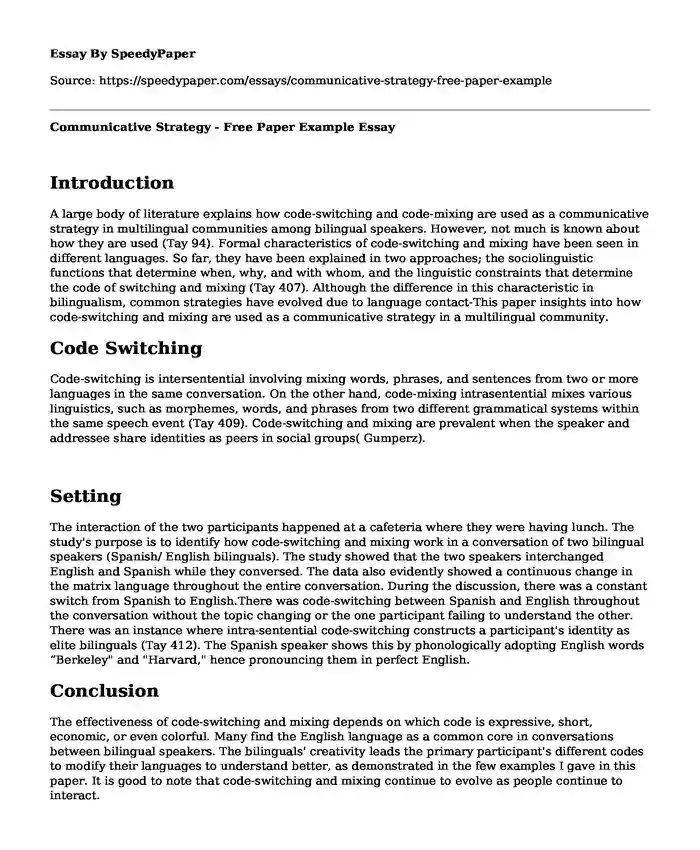
| Type of paper: | Essay |
| Categories: | Communication Languages |
| Pages: | 2 |
| Wordcount: | 446 words |
Introduction
A large body of literature explains how code-switching and code-mixing are used as a communicative strategy in multilingual communities among bilingual speakers. However, not much is known about how they are used (Tay 94). Formal characteristics of code-switching and mixing have been seen in different languages. So far, they have been explained in two approaches; the sociolinguistic functions that determine when, why, and with whom, and the linguistic constraints that determine the code of switching and mixing (Tay 407). Although the difference in this characteristic in bilingualism, common strategies have evolved due to language contact-This paper insights into how code-switching and mixing are used as a communicative strategy in a multilingual community.
Code Switching
Code-switching is intersentential involving mixing words, phrases, and sentences from two or more languages in the same conversation. On the other hand, code-mixing intrasentential mixes various linguistics, such as morphemes, words, and phrases from two different grammatical systems within the same speech event (Tay 409). Code-switching and mixing are prevalent when the speaker and addressee share identities as peers in social groups( Gumperz).
Setting
The interaction of the two participants happened at a cafeteria where they were having lunch. The study's purpose is to identify how code-switching and mixing work in a conversation of two bilingual speakers (Spanish/ English bilinguals). The study showed that the two speakers interchanged English and Spanish while they conversed. The data also evidently showed a continuous change in the matrix language throughout the entire conversation. During the discussion, there was a constant switch from Spanish to English.There was code-switching between Spanish and English throughout the conversation without the topic changing or the one participant failing to understand the other. There was an instance where intra-sentential code-switching constructs a participant's identity as elite bilinguals (Tay 412). The Spanish speaker shows this by phonologically adopting English words “Berkeley" and "Harvard," hence pronouncing them in perfect English.
Conclusion
The effectiveness of code-switching and mixing depends on which code is expressive, short, economic, or even colorful. Many find the English language as a common core in conversations between bilingual speakers. The bilinguals' creativity leads the primary participant's different codes to modify their languages to understand better, as demonstrated in the few examples I gave in this paper. It is good to note that code-switching and mixing continue to evolve as people continue to interact.
Works Cited
Gumperz, John J. Discourse strategies. Vol. 1. Cambridge University Press, 1982.
Tay, Mary WJ. "Code switching and code mixing as a communicative strategy in multilingual discourse." World Englishes 8.3 (1989): 407-417.
Tay, Mary WJ. "Lects and institutionalized varieties of English: The case of Singapore." Issues and Developments in English and Applied Linguistics 1 (1986): 93-107.
Cite this page
Communicative Strategy - Free Paper Example. (2024, Jan 01). Retrieved from https://speedypaper.com/essays/communicative-strategy-free-paper-example
Request Removal
If you are the original author of this essay and no longer wish to have it published on the SpeedyPaper website, please click below to request its removal:
- Free Essay Example: To Write. To Read. To Live
- Personal Essay Sample: Desire to Be a Creative Writer
- Study Abroad - Free Paper with a Personal Statement Sample
- Education Essay Example: Curriculum Implementation
- Summative and Formative Assessment - Free Essay in Education
- Free Essay on the Role of Social and Cultural Factors in the Acquisition of Communication Skills
- Remote Learning During the Pandemic - Free Essay Example
Popular categories




